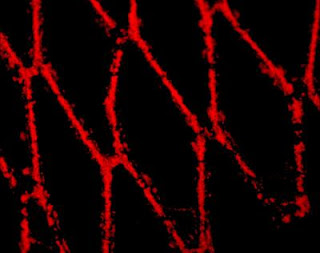The study appears in the Proceedings of the National Academy of Sciences, published online on Jan. 7. Dr. Levy’s group from Children’s Hospital collaborated with engineers from Drexel University and Duke University.
“This is a novel strategy for delivering cells to targets in the body,” said Levy, who added that previous researchers have pursued other, less successful approaches to introduce endothelial cells to diseased blood vessels, in the developing medical field of cell therapy.
Levy’s team created nanoparticles, approximately 290 nanometers across, made of the biodegradable polymer, polylactic acid, and impregnated with iron oxide. (A nanometer is a millionth of a millimeter; in comparison to these nanoparticles, red blood cells are ten to 100 times larger.)
The researchers loaded the nanoparticles into endothelial cells, which had been genetically modified to produce a specific color that could be detected by an imaging system while the animals were alive. After introducing stainless steel stents into rats’ carotid arteries, Levy’s team used magnetic fields to steer the cells into the stents.
Patients with heart disease commonly receive metal stents in partially blocked blood vessels to improve blood flow, both by widening the vessels and delivering drugs. However, many stents fail over time as smooth muscle cells accumulate excessively on their surfaces and create new blockages. One goal of cell therapy is to introduce new endothelial cells to recoat stents with a smooth surface.
Furthermore, Levy adds, while drug-releasing stents currently provide benefits in treating diseased coronary arteries, they have proved far less effective in treating peripheral vascular disease, such as that occurring in patients with diabetes. In such cases, severe problems in blood circulation may force doctors to amputate a leg. In upcoming animal studies, Levy’s team will use their delivery approach to deliver magnetic nanoparticles to peripheral arteries.
Future studies, Levy added, also will use cells derived from the animal itself, to avoid potential rejection problems that may occur with unmatched cells. The current study used unmatched cells, delivering bovine cells to rat arteries, but only over a 48-hour period, too brief for rejection to occur.
The current study builds on research published earlier this year by Levy and collaborators, in which they used magnetic fields and nanoparticles to deliver DNA to arterial muscle cells in culture. That research focused on a delivery system for gene therapy, while the current study represents cell therapy. Levy suggests future applications may combine both therapies, using endothelial cells to deliver beneficial genes to damaged arteries.
The delivery system, says Levy, might also be applied to other sites where physicians implant steel stents to deliver medication, such as the esophagus, bile ducts and lungs. Another potential use might be in orthopedic procedures, in which surgeons implant steel nails to stabilize fractured bones, or use steel screws to correct spinal abnormalities. In such cases, magnetized nanoparticles might deliver bone stem cells to strengthen bony structures.
“Magnetic fields produced by ordinary MRI machines could suffice to deliver cells to targets where they could promote healing, since MRI uses uniform fields, which are key to our targeting strategy,” added Levy. “This method could become a powerful medical tool.” ###
Financial support for the study came from the National Institutes of Health, the Nanotechnology Institute, and both the William J. Rashkind Endowment and Erin’s Fund of The Children’s Hospital of Philadelphia. Dr. Levy’s co-authors were Ilia Fishbein, M.D., Michael Chorny, Ph.D., Ivan S. Alferiev, Ph.D., and Darryl Williams, of Children’s Hospital; Boris Polyak, M.D., and Gary Friedman, Ph.D., of Drexel University; and Ben Yellen, Ph.D., of Duke University.
About The Children’s Hospital of Philadelphia: The Children's Hospital of Philadelphia was founded in 1855 as the nation's first pediatric hospital. Through its long-standing commitment to providing exceptional patient care, training new generations of pediatric healthcare professionals and pioneering major research initiatives, Children’s Hospital has fostered many discoveries that have benefited children worldwide. Its pediatric research program is among the largest in the country, ranking third in National Institutes of Health funding. In addition, its unique family-centered care and public service programs have brought the 430-bed hospital recognition as a leading advocate for children and adolescents. For more information, visit chop.edu.
Contact: John Ascenzi Ascenzi@email.chop.edu 267-426-6055 Children's Hospital of Philadelphia
Technorati Tags: Nano or Nanotechnology and Nanotech or Children's Hospital of Philadelphia and Magnetically guided nanoparticles or John McCain TV Ad: "Michigan Endorsed" VIDEO and Garrett Augustus Morgan, Sr. and National Nanotechnology Initiative releases new strategic plan















No comments:
Post a Comment